Tonight at 10 p.m., ABC will air the premiere of 666 Park Avenue, a new show about an Upper East Side apartment building whose residents make a deal with the devil. But the facade of this haunted building may seem familiar — that’s because they used the Upper West Side’s famous Ansonia on 73rd Street as the set for the exterior shots. Are you outraged? Us neither. And yet, it does feel a bit wrong, doesn’t it? Check out the trailer below, and a column about this pressing issue that we first published a couple of months ago.
(We wrote a short piece about the filming of 666 Park Avenue here. If you watch the show let us know what you think in the comments or on our facebook page.)
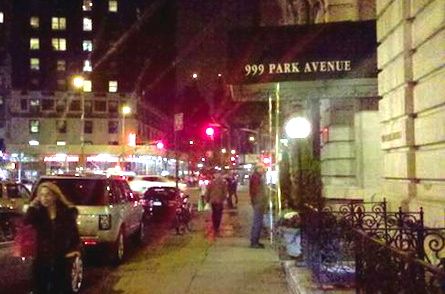
The set of “999 Park Avenue,” back in March.
By Stan Solomon
On Sunday evenings this Fall, a supernatural-themed prime time drama called 666 Park Avenue is set to air on ABC. But the Upper East Side drama has a twist – and it’s not just the whole haunted-apartment-building thing. The exterior shots that claim to show “the premier apartment building on Manhattan’s Upper East Side” are of an Upper West Side building. And not just any building.
Once again, Hollywood seems to be playing fast-and-loose with New York, and especially with our Upper West Side. And this time they are picking on one of our true icons – The Ansonia.
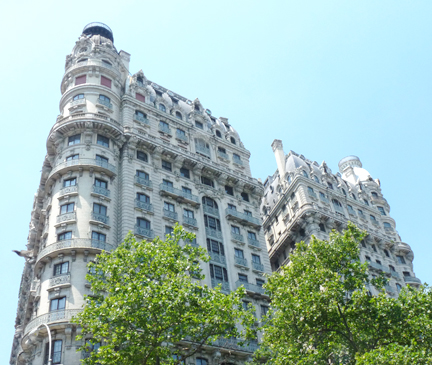 Yes, the Ansonia, that historic, overly-decorated wedding cake of a building, done in the style of fin-de-siecle Paris and occupying the entire block-front on the west side of Broadway from 73rd to 74th Streets.
Yes, the Ansonia, that historic, overly-decorated wedding cake of a building, done in the style of fin-de-siecle Paris and occupying the entire block-front on the west side of Broadway from 73rd to 74th Streets.
Of course, loyal West Side Rag devotees learned of this on March 18. But still it was a shock to see The Ansonia on The Big Screen, appearing in a brief aerial shot.
Technically that sequence was part of “establishing footage,” so called because it “establishes” in the viewer’s mind a link between a building’s exterior and its “interior” – usually a set on a Hollywood sound stage. Think of the shots of Jerry’s apartment house that opened every episode of Seinfeld …although reportedly that exceptionally bland building façade really is somewhere in Los Angeles, a.k.a. ‘The Land of the Bland.’ ).
But, promises the Official Press Release for 666 Park Avenue, this dramatic series will be anything but bland. It centers on (drumroll, please) The Drake, (or, as pronounced by some here on the UWS, The Drek).
Obviously that press release was written by some Left Coast type totally unfamiliar with New York real estate, especially the very exclusive Fifth Avenue co-ops, like the famed 740 Fifth or its brethren. Then again, 740’s long list of amenities does not include Satanic forces.
Which, of course, The Drake does, or there would be no plot. And that plot revolves around the show’s protagonists, a “young (and, of course, both Hollywood-beautiful and heterosexual) Mid-western couple” hired as managers. Obviously there were no qualified candidates in all of New York. But these two Every-Americans will soon discover (between commercial-breaks) that something is rotten in Den … err… 666. One of the show’s tag-lines is “Welcome to The Drake, where your desires can come true…for a price.” For a price???; well, duhh…Welcome to Manhattan!
The show’s creators, of course, are hoping that the 666 reference will help even the slowest-witted viewer to grasp that this building’s residents have made deals with the Devil. The number 666, or “The Mark of the Beast, is usually associated with all things Satanic. Except, perhaps, here in New York, where until recently a huge “666” in red neon was proudly displayed atop a Fifth Avenue skyscraper. Inside, and just below those numbers, was the pricey “Top of the Sixes” restaurant. But today the “666” is gone, replaced by a Citigroup logo, and also gone is the restaurant. The building, an unspectacular “International Style” upended cracker box, seems more ordinary than evil – although, as home to both a Hollister and a Uniqlo store, it does attract gaggles of gawking tourists.
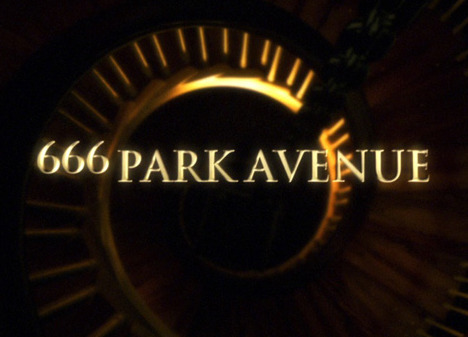 Which, thankfully, the real 666 Park Avenue does not… yet. Until the show airs and the star-obsessed come swarming uptown to see it. Which will be a confusing experience, because this 666 is full of “nots”: it is not “home to dozens of residents,” not a true apartment building, and certainly not on Park Avenue. It is a “Maisonette,” (little house, no prairie) around the corner on East 67th, physically attached to 660 Park Avenue but with its own entrance…and address. A 27-room triplex, it was built for a Vanderbilt (Ms. William K. Vanderbilt II) and sports two double-height ballrooms, one of which, at 1,012 square feet, is larger than some city apartments. A July 16, 1981 New York Times story gushed over what, to the writer, was “SURELY the greatest maisonette ever constructed in New York.”
Which, thankfully, the real 666 Park Avenue does not… yet. Until the show airs and the star-obsessed come swarming uptown to see it. Which will be a confusing experience, because this 666 is full of “nots”: it is not “home to dozens of residents,” not a true apartment building, and certainly not on Park Avenue. It is a “Maisonette,” (little house, no prairie) around the corner on East 67th, physically attached to 660 Park Avenue but with its own entrance…and address. A 27-room triplex, it was built for a Vanderbilt (Ms. William K. Vanderbilt II) and sports two double-height ballrooms, one of which, at 1,012 square feet, is larger than some city apartments. A July 16, 1981 New York Times story gushed over what, to the writer, was “SURELY the greatest maisonette ever constructed in New York.”
Although The Times hyper-ventilated over 666 Park Avenue’s interiors (“To call it a maisonette at all is rather like calling a Bugatti a runabout”), its exterior, like that of the larger 660 Park Avenue’s, is … nothing special. It was done in Italian Renaissance style by York and Sawyer, ironically the same firm that designed the Upper West Side’s Apple Bank…which may explain why it looks somewhat like an early 20th-Century bank. And, to be honest…or snarky…or both, much of Park Avenue’s exteriors have that “old-money elegance,” and hence are…stodgy?
Which explains why the show wants The Ansonia for exterior shots. Nothing about that 1904 classic can be called stodgy! According to the AIA Guide to New York City – the “Bible” for NYC architecture – it was the very Landmark Preservation Commission that called The Ansonia’s effect “one of joyous exuberance profiled against the sky.” And the Guide itself says the building is “one of New York’s architectural gems,” as evidenced by: the hundreds of elaborate limestone carvings, the double-height lobby windows, the Juliet Balconies at almost every apartment window, and, atop the 73rd and 74th Street corners, those truly odd towers, topped with what appears to be … gigantic fruit baskets?!?
Thank developer William Earle Dodge (W.E.D.) Stokes, the controversial heir to the Phelps-Dodge copper-mining fortune, who, in 1899, commissioned a Parisian architect to build Manhattan’s grandest hotel. Which it was. According to Stephen Gainses’s The Sky’s the Limit, it was once “the largest mixed apartment/hotel building in the city,” and at its opening it featured some 1,400 rooms and 300 suites. To give the full history of The Ansonia, including the contentious tenant/owner vs. management issues of the 1980 and 90s, is clearly beyond this article (indeed, Gaines devotes an entire chapter to Stokes and his hotel).
But, here are The Top Five Most Interesting Facts About The Ansonia:
# Five: There was never a need for residents to search for a neighborhood restaurant, as The Ansonia had: a central kitchen and a dining room holding 550, as well as serving kitchens on each floor for those who chose to dine alone. Thus, no need to keep one’s take-out menus (had they existed) in a shoebox;
# Four: Because it was intended as a residence for “artistes,” including opera singers and classical musicians (Enrico Caruso, Igor Stravinsky, and Arturo Toscanini all lived there at some time), its walls were made extra-extra thick. Which probably helped during one’s neighbors’ inevitable domestic squabbles. Consider this (anachronistic) advertising slogan: “At The Ansonia, as in space, no one can hear you scream!”;
# Three: Like many a luxury hotel, in its pre-Depression era hey-days, The Ansonia had guest amenities, like an on-site tailor, a basement shopping arcade, a palm court, and a Turkish bath. Unlike most hotels, it also for a time had live seals in its lobby fountain;
# Two: Predating Williamsburg’s trendy hipster-run rooftop urban “farms” by a century, The Ansonia, for its first three years, had its own rooftop poultry farm, which supplied fresh eggs daily to all tenants. The Department of Health stepped in, ordering it shut down in 1907; AND…
# One: From 1968, and for the next five years, The Ansonia hosted the Continental Baths, a gay bathhouse with swimming pool / disco dance floor / and cabaret lounge. That lounge attracted dozens of top performers … and a then-unknown Bette Midler, who got her start there as “Bathhouse Betty.” Her accompanist was Barry Manilow – but probably no one ever called him “Bathhouse Barry.” The Continental Baths closed in 1974, only to re-emerge from 1977 till 1980 as Plato’s Retreat, a heterosexual “Swingers’ Club.”
 So perhaps Hollywood was not entirely wrong in picking The Ansonia as stand-in for the much-less interesting 666 Park Avenue. They actually lucked out, choosing a building with its own dark past. Okay, it’s not as eerie as The Dakota, the setting for Rosemarys Baby with its flickering gas lamps at the 72nd Street entrance, and exactly what are those scary-weird creatures holding the Central Park West side railing in their mouths?
So perhaps Hollywood was not entirely wrong in picking The Ansonia as stand-in for the much-less interesting 666 Park Avenue. They actually lucked out, choosing a building with its own dark past. Okay, it’s not as eerie as The Dakota, the setting for Rosemarys Baby with its flickering gas lamps at the 72nd Street entrance, and exactly what are those scary-weird creatures holding the Central Park West side railing in their mouths?
But The Ansonia does also have its scary side. As proof, who…or what…is represented by that carved creature leering at visitors above the 74th Street entrance (see photograph at left). Could this be The Wicked One?
Also, consider this. By setting their be-deviled building on Park Avenue, the show’s creators are denying its fictional residents the opportunity to do some quick shopping, as Park Avenue famously has no commercial development. In other words, folks living in The Drake cannot easily buy a Drake’s Devil Dog®. But folks in The Ansonia certainly may, as Fairway is a mere footsteps away. There one can easily find: Devil’s Food Cake…Underwood’s Deviled Ham®…and a host of other devilishly-good food.
Top photo by Aaron Judell. 666 Park Avenue logo via ABC. Other photos by Stan Solomon.






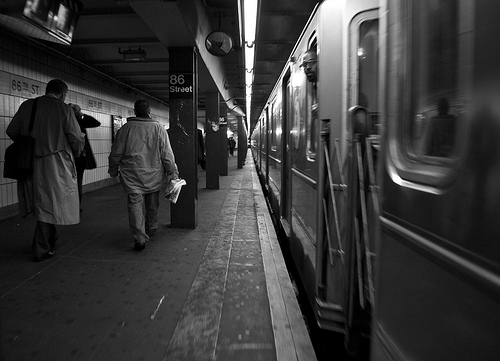
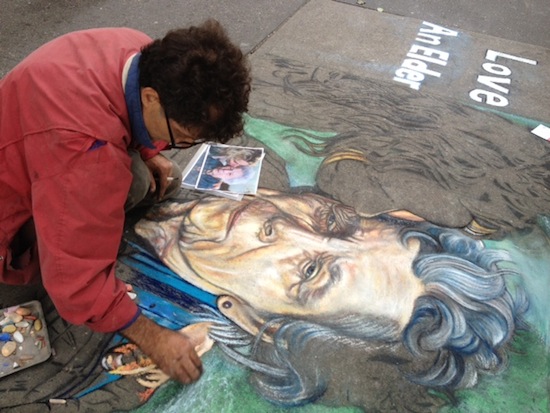

um – I *think* you meant 740 PARK, not Fifth?